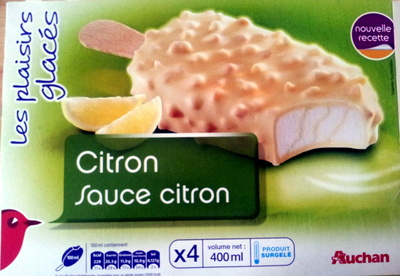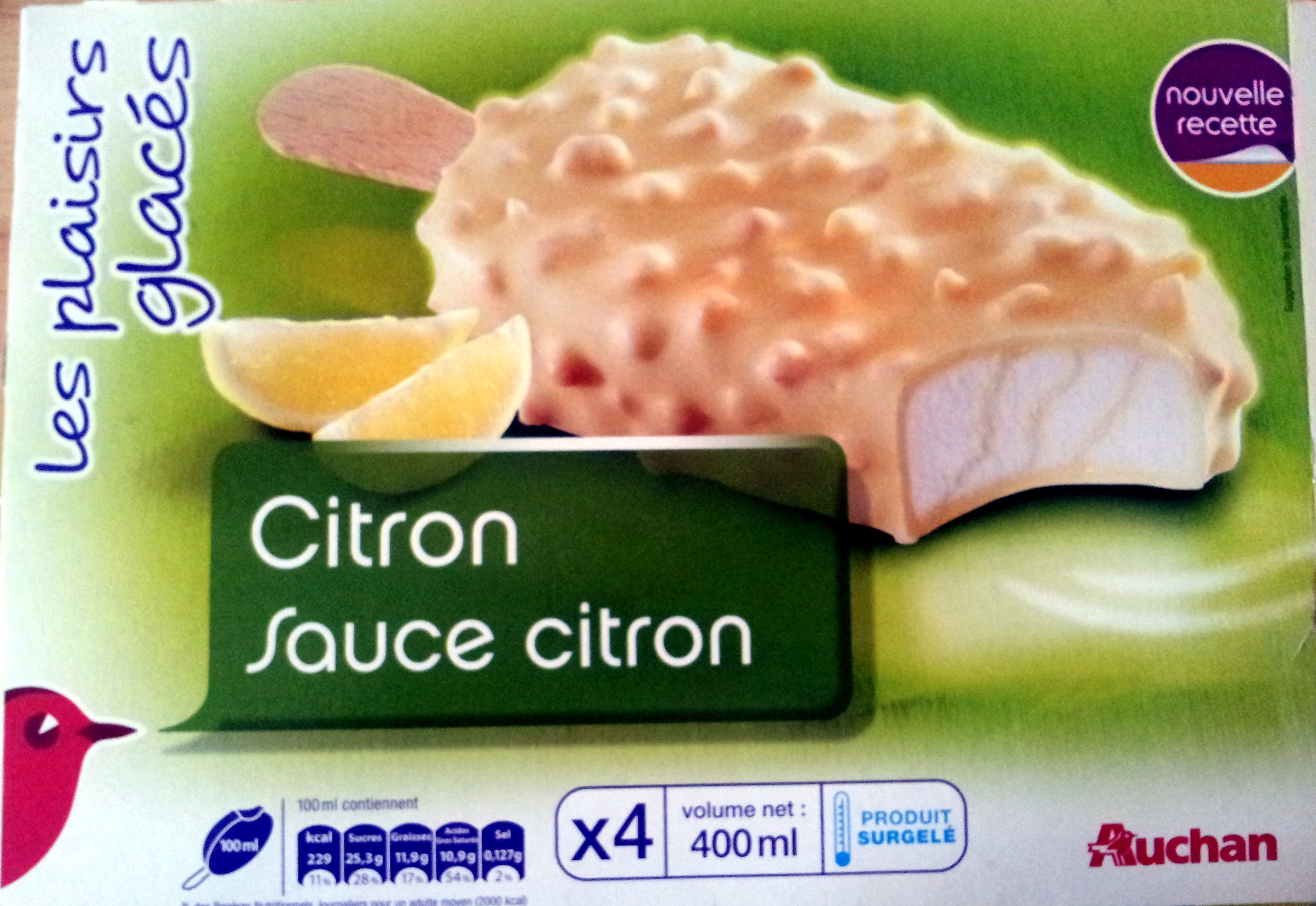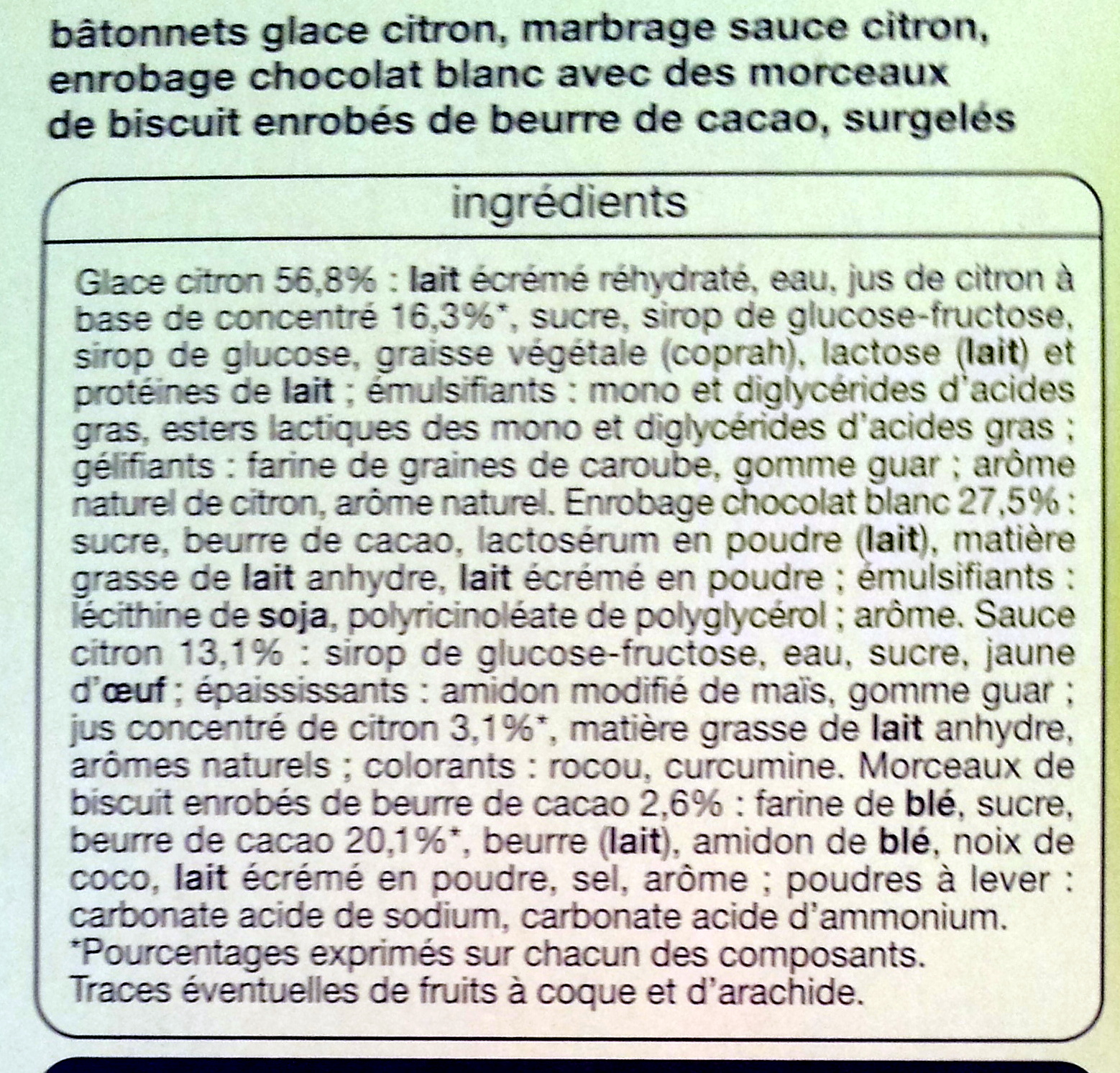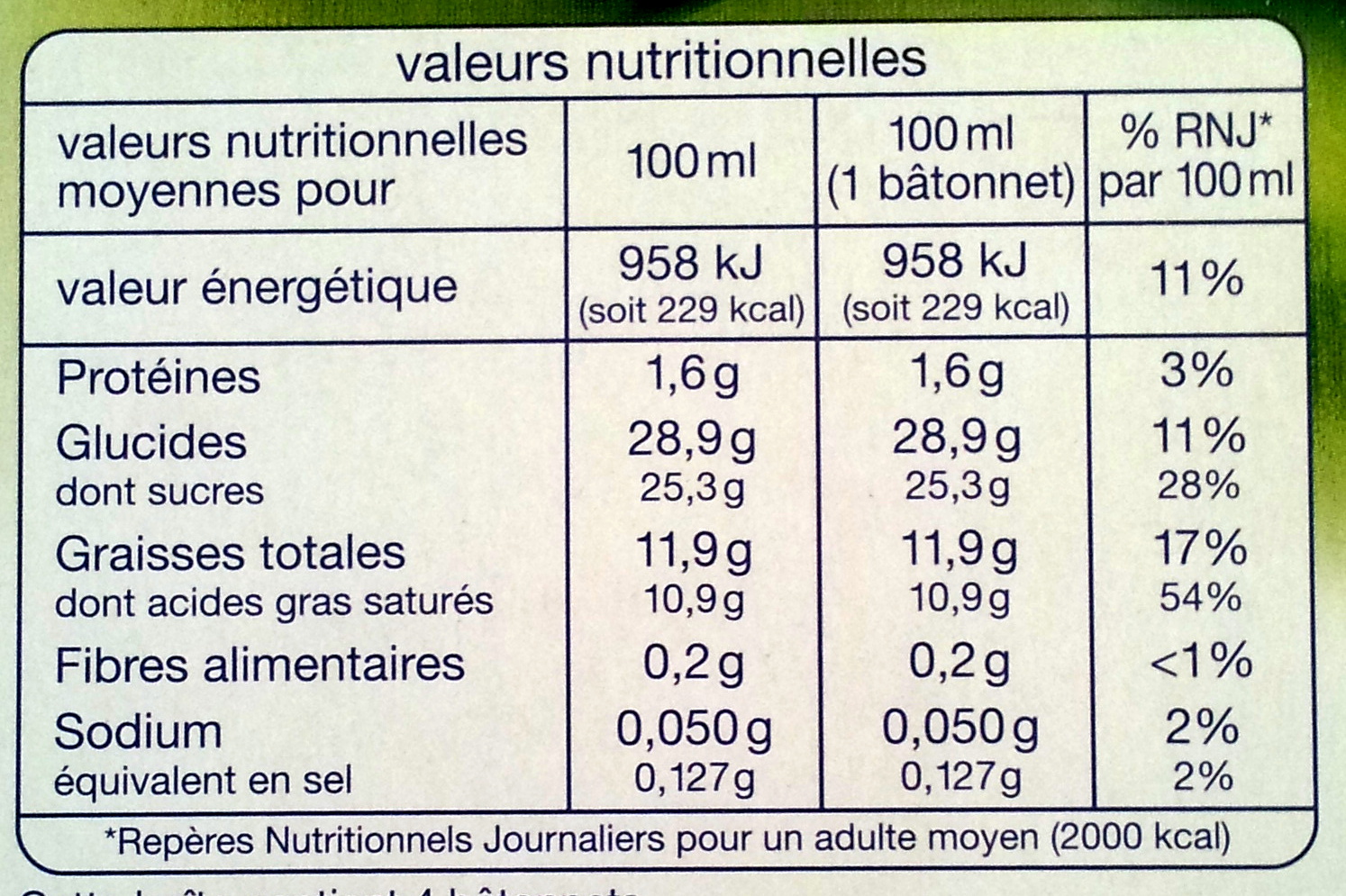Help us make food transparency the norm!
As a non-profit organization, we depend on your donations to continue informing consumers around the world about what they eat.
The food revolution starts with you!
Bâtonnets Citron Sauce Sitron - Auchan - 400 ml (4 * 100ml) / 306 g e
Bâtonnets Citron Sauce Sitron - Auchan - 400 ml (4 * 100ml) / 306 g e
Important note: this product is no longer sold. The data is kept for reference only. This product does not appear in regular searches and is not taken into account for statistics. (Withdrawal date: 2023/07/01)
This product page is not complete. You can help to complete it by editing it and adding more data from the photos we have, or by taking more photos using the app for Android or iPhone/iPad. Thank you!
×
Some of the data for this product has been provided directly by the manufacturer AUCHAN APAW.
Barcode: 3596710335985 (EAN / EAN-13)
Quantity: 400 ml (4 * 100ml) / 306 g e
Packaging: Plastic, Bag, Cardboard, Frozen
Brands: Auchan
Categories: Desserts, Frozen foods, Frozen desserts, Ice creams and sorbets, Ice creams
Labels, certifications, awards:
Green Dot, Made in France
Traceability code: EMB 29181 - Plouédern (Finistère, France)
Stores: Auchan
Countries where sold: France
Matching with your preferences
Health
Ingredients
-
58 ingredients
: Glace citron 56.8 % : lait réhydraté, eau, jus de citron à base de concentré 16,3 %, sucre, sirop de glucose—fructose, sirop de glucose, graisse végétale (coprah), lactose (_) et protéines de _, émulsifiants : mono et diglycerides d'acides gras, esters lactiques des mono et diglycérides d'acides gras : gélifiants : farine de graines de caroube, gomme guar, arôme naturel de citron, arôme naturel. Enrobage chocolat blanc 27.5 %: sucre, beurre de cacao, lactosérum en poudre (_), matière grasse de _ anhydre, _ écrémé en poudre, émulsifiants : lécithine de soja, polyricinoléate de polyglycérol, arôme. Sauce citron 13,1% : sirop de glucose-fructose, eau, sucre, jaune d’œuf, épaississants : amidon modifié de mais, gomme guar , jus concentré de citron 3.1 %, matière grasse de lait anhydre, arômes naturels ; colorants : rocou, curcumine. Morceaux de biscuit enrobés de beurre de cacao 2,6% : farine de blé, sucre, beurre de cacao 20,1 %, beurre (_), amidon de blé, noix de coco, _ écrémé en poudre, sel, arôme ; poudres à lever : carbonate acide de sodium, carbonate acide d’ammonium.Allergens: Eggs, Gluten, MilkTraces: Nuts, Peanuts
Food processing
-
Ultra processed foods
Elements that indicate the product is in the 4 - Ultra processed food and drink products group:
- Additive: E100 - Curcumin
- Additive: E14XX - Modified Starch
- Additive: E160b - Annatto
- Additive: E322 - Lecithins
- Additive: E412 - Guar gum
- Additive: E471 - Mono- and diglycerides of fatty acids
- Additive: E472b - Lactic acid esters of mono- and diglycerides of fatty acids
- Additive: E476 - Polyglycerol polyricinoleate
- Ingredient: Colour
- Ingredient: Emulsifier
- Ingredient: Flavouring
- Ingredient: Gelling agent
- Ingredient: Glucose
- Ingredient: Glucose syrup
- Ingredient: Lactose
- Ingredient: Thickener
- Ingredient: Whey
Food products are classified into 4 groups according to their degree of processing:
- Unprocessed or minimally processed foods
- Processed culinary ingredients
- Processed foods
- Ultra processed foods
The determination of the group is based on the category of the product and on the ingredients it contains.
Additives
-
E322 - Lecithins
Lecithins are natural compounds commonly used in the food industry as emulsifiers and stabilizers.
Extracted from sources like soybeans and eggs, lecithins consist of phospholipids that enhance the mixing of oil and water, ensuring smooth textures in various products like chocolates, dressings, and baked goods.
They do not present any known health risks.
-
E322i - Lecithin
Lecithins are natural compounds commonly used in the food industry as emulsifiers and stabilizers.
Extracted from sources like soybeans and eggs, lecithins consist of phospholipids that enhance the mixing of oil and water, ensuring smooth textures in various products like chocolates, dressings, and baked goods.
They do not present any known health risks.
-
E412 - Guar gum
Guar gum (E412) is a natural food additive derived from guar beans.
This white, odorless powder is valued for its remarkable thickening and stabilizing properties, making it a common ingredient in various food products, including sauces, dressings, and ice creams.
When used in moderation, guar gum is considered safe for consumption, with no known adverse health effects.
-
E471 - Mono- and diglycerides of fatty acids
Mono- and diglycerides of fatty acids (E471), are food additives commonly used as emulsifiers in various processed foods.
These compounds consist of glycerol molecules linked to one or two fatty acid chains, which help stabilize and blend water and oil-based ingredients. E471 enhances the texture and shelf life of products like margarine, baked goods, and ice cream, ensuring a smooth and consistent texture.
It is generally considered safe for consumption within established regulatory limits.
-
E476 - Polyglycerol polyricinoleate
Polyglycerol polyricinoleate: Polyglycerol polyricinoleate -PGPR-, E476, is an emulsifier made from glycerol and fatty acids -usually from castor bean, but also from soybean oil-. In chocolate, compound chocolate and similar coatings, PGPR is mainly used with another substance like lecithin to reduce viscosity. It is used at low levels -below 0.5%-, and works by decreasing the friction between the solid particles -e.g. cacao, sugar, milk- in molten chocolate, reducing the yield stress so that it flows more easily, approaching the behaviour of a Newtonian fluid. It can also be used as an emulsifier in spreads and in salad dressings, or to improve the texture of baked goods. It is made up of a short chain of glycerol molecules connected by ether bonds, with ricinoleic acid side chains connected by ester bonds. PGPR is a yellowish, viscous liquid, and is strongly lipophilic: it is soluble in fats and oils and insoluble in water and ethanol.Source: Wikipedia
-
E500 - Sodium carbonates
Sodium carbonates (E500) are compounds commonly used in food preparation as leavening agents, helping baked goods rise by releasing carbon dioxide when they interact with acids.
Often found in baking soda, they regulate the pH of food, preventing it from becoming too acidic or too alkaline. In the culinary world, sodium carbonates can also enhance the texture and structure of foods, such as noodles, by modifying the gluten network.
Generally recognized as safe, sodium carbonates are non-toxic when consumed in typical amounts found in food.
-
E500ii - Sodium hydrogen carbonate
Sodium hydrogen carbonate, also known as E500ii, is a food additive commonly used as a leavening agent.
When added to recipes, it releases carbon dioxide gas upon exposure to heat or acids, causing dough to rise and resulting in a light, fluffy texture in baked goods.
It is generally recognized as safe (GRAS) by regulatory authorities when used in appropriate quantities and poses no significant health risks when consumed in typical food applications.
-
E503 - Ammonium carbonates
Ammonium carbonate: Ammonium carbonate is a salt with the chemical formula -NH4-2CO3. Since it readily degrades to gaseous ammonia and carbon dioxide upon heating, it is used as a leavening agent and also as smelling salt. It is also known as baker's ammonia and was a predecessor to the more modern leavening agents baking soda and baking powder. It is a component of what was formerly known as sal volatile and salt of hartshorn.Source: Wikipedia
-
E503ii - Ammonium hydrogen carbonate
Ammonium carbonate: Ammonium carbonate is a salt with the chemical formula -NH4-2CO3. Since it readily degrades to gaseous ammonia and carbon dioxide upon heating, it is used as a leavening agent and also as smelling salt. It is also known as baker's ammonia and was a predecessor to the more modern leavening agents baking soda and baking powder. It is a component of what was formerly known as sal volatile and salt of hartshorn.Source: Wikipedia
Ingredients analysis
-
May contain palm oil
Ingredients that may contain palm oil: E471
-
Non-vegan
Non-vegan ingredients: Milk, Lactose, Whey powder, Egg yolk, ButterSome ingredients could not be recognized.
We need your help!
You can help us recognize more ingredients and better analyze the list of ingredients for this product and others:
- Edit this product page to correct spelling mistakes in the ingredients list, and/or to remove ingredients in other languages and sentences that are not related to the ingredients.
- Add new entries, synonyms or translations to our multilingual lists of ingredients, ingredient processing methods, and labels.
If you would like to help, join the #ingredients channel on our Slack discussion space and/or learn about ingredients analysis on our wiki. Thank you!
-
Vegetarian status unknown
Unrecognized ingredients: fr:glace-citron, fr:, fr:enrobage-chocolat-blanc, fr:, fr:matiere-grasse-de-anhydre, fr:ecreme-en-poudre, fr:sauce-citron, fr:Matière grasse de lait anhydre, fr:morceaux-de-biscuit-enrobes-de-beurre-de-cacao, fr:, fr:ecreme-en-poudreSome ingredients could not be recognized.
We need your help!
You can help us recognize more ingredients and better analyze the list of ingredients for this product and others:
- Edit this product page to correct spelling mistakes in the ingredients list, and/or to remove ingredients in other languages and sentences that are not related to the ingredients.
- Add new entries, synonyms or translations to our multilingual lists of ingredients, ingredient processing methods, and labels.
If you would like to help, join the #ingredients channel on our Slack discussion space and/or learn about ingredients analysis on our wiki. Thank you!
-
Details of the analysis of the ingredients
We need your help!
Some ingredients could not be recognized.
We need your help!
You can help us recognize more ingredients and better analyze the list of ingredients for this product and others:
- Edit this product page to correct spelling mistakes in the ingredients list, and/or to remove ingredients in other languages and sentences that are not related to the ingredients.
- Add new entries, synonyms or translations to our multilingual lists of ingredients, ingredient processing methods, and labels.
If you would like to help, join the #ingredients channel on our Slack discussion space and/or learn about ingredients analysis on our wiki. Thank you!
: Glace citron 56.8% (_lait_), eau, jus de citron à base de concentré 16.3%, sucre, sirop de glucose-fructose, sirop de glucose, graisse végétale (coprah), lactose (_), protéines de _, émulsifiants (mono- et diglycerides d'acides gras), esters lactiques des mono- et diglycérides d'acides gras (gélifiants), farine de graines de caroube, gomme guar, arôme naturel de citron, arôme naturel, Enrobage chocolat blanc 27.5%, beurre de cacao, lactosérum en poudre (_), matière grasse de _ anhydre, _ écrémé en poudre, émulsifiants (lécithine de soja), polyricinoléate de polyglycérol, arôme, Sauce citron 13.1% (sirop de glucose-fructose), eau, sucre, jaune d'_œuf_, épaississants (amidon modifié de mais), gomme guar, jus concentré de citron 3.1%, matière grasse de lait anhydre, arômes naturels, colorants (rocou), curcumine, Morceaux de biscuit enrobés de beurre de cacao 2.6% (farine de _blé_), sucre, beurre de cacao 20.1%, beurre (_), amidon de _blé_, noix de coco, _ écrémé en poudre, sel, arôme, poudres à lever (carbonate acide de sodium), carbonate acide d'ammonium- Glace citron -> fr:glace-citron - percent: 56.8
- _lait_ -> en:milk - vegan: no - vegetarian: yes
- eau -> en:water - vegan: yes - vegetarian: yes - ciqual_food_code: 18066
- jus de citron à base de concentré -> en:lemon-juice-from-concentrate - vegan: yes - vegetarian: yes - ciqual_food_code: 2028 - percent: 16.3
- sucre -> en:sugar - vegan: yes - vegetarian: yes
- sirop de glucose-fructose -> en:glucose-fructose-syrup - vegan: yes - vegetarian: yes - ciqual_food_code: 31077
- sirop de glucose -> en:glucose-syrup - vegan: yes - vegetarian: yes
- graisse végétale -> en:vegetable-fat - vegan: yes - vegetarian: yes - from_palm_oil: maybe
- coprah -> en:coconut-oil - vegan: yes - vegetarian: yes - from_palm_oil: no
- lactose -> en:lactose - vegan: no - vegetarian: yes
- _ -> fr:
- protéines de _ -> en:protein - vegan: maybe - vegetarian: maybe
- émulsifiants -> en:emulsifier
- mono- et diglycerides d'acides gras -> en:e471 - vegan: maybe - vegetarian: maybe - from_palm_oil: maybe
- esters lactiques des mono- et diglycérides d'acides gras -> en:e472b - vegan: maybe - vegetarian: maybe - from_palm_oil: maybe
- gélifiants -> en:gelling-agent
- farine de graines de caroube -> en:carob-seed-flour - vegan: yes - vegetarian: yes
- gomme guar -> en:e412 - vegan: yes - vegetarian: yes
- arôme naturel de citron -> en:natural-lemon-flavouring - vegan: yes - vegetarian: yes
- arôme naturel -> en:natural-flavouring - vegan: maybe - vegetarian: maybe
- Enrobage chocolat blanc -> fr:enrobage-chocolat-blanc - percent: 27.5
- beurre de cacao -> en:cocoa-butter - vegan: yes - vegetarian: yes - ciqual_food_code: 16030
- lactosérum en poudre -> en:whey-powder - vegan: no - vegetarian: maybe
- _ -> fr:
- matière grasse de _ anhydre -> fr:matiere-grasse-de-anhydre
- _ écrémé en poudre -> fr:ecreme-en-poudre
- émulsifiants -> en:emulsifier
- lécithine de soja -> en:soya-lecithin - vegan: yes - vegetarian: yes - ciqual_food_code: 42200
- polyricinoléate de polyglycérol -> en:e476 - vegan: yes - vegetarian: yes
- arôme -> en:flavouring - vegan: maybe - vegetarian: maybe
- Sauce citron -> fr:sauce-citron - percent: 13.1
- sirop de glucose-fructose -> en:glucose-fructose-syrup - vegan: yes - vegetarian: yes - ciqual_food_code: 31077
- eau -> en:water - vegan: yes - vegetarian: yes - ciqual_food_code: 18066
- sucre -> en:sugar - vegan: yes - vegetarian: yes
- jaune d'_œuf_ -> en:egg-yolk - vegan: no - vegetarian: yes - ciqual_food_code: 22002
- épaississants -> en:thickener
- amidon modifié de mais -> en:modified-corn-starch - vegan: yes - vegetarian: yes - ciqual_food_code: 9510
- gomme guar -> en:e412 - vegan: yes - vegetarian: yes
- jus concentré de citron -> en:concentrated-lemon-juice - vegan: yes - vegetarian: yes - ciqual_food_code: 2028 - percent: 3.1
- matière grasse de lait anhydre -> fr:matiere-grasse-de-lait-anhydre
- arômes naturels -> en:natural-flavouring - vegan: maybe - vegetarian: maybe
- colorants -> en:colour
- rocou -> en:e160b - vegan: yes - vegetarian: yes
- curcumine -> en:e100 - vegan: yes - vegetarian: yes
- Morceaux de biscuit enrobés de beurre de cacao -> fr:morceaux-de-biscuit-enrobes-de-beurre-de-cacao - percent: 2.6
- farine de _blé_ -> en:wheat-flour - vegan: yes - vegetarian: yes
- sucre -> en:sugar - vegan: yes - vegetarian: yes
- beurre de cacao -> en:cocoa-butter - vegan: yes - vegetarian: yes - ciqual_food_code: 16030 - percent: 20.1
- beurre -> en:butter - vegan: no - vegetarian: yes
- _ -> fr:
- amidon de _blé_ -> en:wheat-starch - vegan: yes - vegetarian: yes
- noix de coco -> en:coconut - vegan: yes - vegetarian: yes
- _ écrémé en poudre -> fr:ecreme-en-poudre
- sel -> en:salt - vegan: yes - vegetarian: yes - ciqual_food_code: 11058
- arôme -> en:flavouring - vegan: maybe - vegetarian: maybe
- poudres à lever -> en:raising-agent
- carbonate acide de sodium -> en:e500ii - vegan: yes - vegetarian: yes
- carbonate acide d'ammonium -> en:e503ii - vegan: yes - vegetarian: yes
Nutrition
-
Poor nutritional quality
⚠ ️Warning: the amount of fruits, vegetables and nuts is not specified on the label, it was estimated from the list of ingredients: 19This product is not considered a beverage for the calculation of the Nutri-Score.
Positive points: 0
- Proteins: 0 / 5 (value: 1.6, rounded value: 1.6)
- Fiber: 0 / 5 (value: 0.2, rounded value: 0.2)
- Fruits, vegetables, nuts, and colza/walnut/olive oils: 0 / 5 (value: 19.4, rounded value: 19.4)
Negative points: 17
- Energy: 2 / 10 (value: 958, rounded value: 958)
- Sugars: 5 / 10 (value: 25.3, rounded value: 25.3)
- Saturated fat: 10 / 10 (value: 10.9, rounded value: 10.9)
- Sodium: 0 / 10 (value: 50.8, rounded value: 50.8)
The points for proteins are not counted because the negative points are greater or equal to 11.
Nutritional score: 17 (17 - 0)
Nutri-Score: D
-
Nutrient levels
-
Fat in moderate quantity (11.9%)
What you need to know- A high consumption of fat, especially saturated fats, can raise cholesterol, which increases the risk of heart diseases.
Recommendation: Limit the consumption of fat and saturated fat- Choose products with lower fat and saturated fat content.
-
Saturated fat in high quantity (10.9%)
What you need to know- A high consumption of fat, especially saturated fats, can raise cholesterol, which increases the risk of heart diseases.
Recommendation: Limit the consumption of fat and saturated fat- Choose products with lower fat and saturated fat content.
-
Sugars in high quantity (25.3%)
What you need to know- A high consumption of sugar can cause weight gain and tooth decay. It also augments the risk of type 2 diabetes and cardio-vascular diseases.
Recommendation: Limit the consumption of sugar and sugary drinks- Sugary drinks (such as sodas, fruit beverages, and fruit juices and nectars) should be limited as much as possible (no more than 1 glass a day).
- Choose products with lower sugar content and reduce the consumption of products with added sugars.
-
Salt in low quantity (0.127%)
What you need to know- A high consumption of salt (or sodium) can cause raised blood pressure, which can increase the risk of heart disease and stroke.
- Many people who have high blood pressure do not know it, as there are often no symptoms.
- Most people consume too much salt (on average 9 to 12 grams per day), around twice the recommended maximum level of intake.
Recommendation: Limit the consumption of salt and salted food- Reduce the quantity of salt used when cooking, and don't salt again at the table.
- Limit the consumption of salty snacks and choose products with lower salt content.
-
-
Nutrition facts
Nutrition facts As sold
for 100 g / 100 mlAs sold
per serving (100 ml)Compared to: Ice creams Energy 958 kj
(229 kcal)958 kj
(229 kcal)-1% Fat 11.9 g 11.9 g +3% Saturated fat 10.9 g 10.9 g +45% Carbohydrates 28.9 g 28.9 g +3% Sugars 25.3 g 25.3 g +11% Fiber 0.2 g 0.2 g -78% Proteins 1.6 g 1.6 g -52% Salt 0.127 g 0.127 g -23% Fruits‚ vegetables‚ nuts and rapeseed‚ walnut and olive oils (estimate from ingredients list analysis) 19.4 % 19.4 %
Environment
-
Eco-Score B - Low environmental impact
⚠ ️Select a country in order to include the full impact of transportation.The Eco-Score is an experimental score that summarizes the environmental impacts of food products.→ The Eco-Score was initially developped for France and it is being extended to other European countries. The Eco-Score formula is subject to change as it is regularly improved to make it more precise and better suited to each country.Life cycle analysis
-
Average impact of products of the same category: A (Score: 87/100)
Category: Ice cream, cone (normal size)
Category: Ice cream, cone (normal size)
- PEF environmental score: 0.22 (the lower the score, the lower the impact)
- including impact on climate change: 1.75 kg CO2 eq/kg of product
Stage Impact Agriculture
56.9 %Processing
18.1 %Packaging
6.7 %Transportation
6.9 %Distribution
7.2 %Consumption
4.2 %
Bonuses and maluses
-
Missing origins of ingredients information
Malus: -5
⚠ ️ The origins of the ingredients of this product are not indicated.
If they are indicated on the packaging, you can modify the product sheet and add them.
If you are the manufacturer of this product, you can send us the information with our free platform for producers.
-
Packaging with a medium impact
Malus: -11
Shape Material Recycling Impact Bag Plastic High Unknown Cardboard Low ⚠ ️ The information about the packaging of this product is not sufficiently precise (exact shapes and materials of all components of the packaging).⚠ ️ For a more precise calculation of the Eco-Score, you can modify the product page and add them.
If you are the manufacturer of this product, you can send us the information with our free platform for producers.
Eco-Score for this product
-
Impact for this product: B (Score: 71/100)
Product: Bâtonnets Citron Sauce Sitron - Auchan - 400 ml (4 * 100ml) / 306 g e
Life cycle analysis score: 87
Sum of bonuses and maluses: -16
Final score: 71/100
-
Carbon footprint
-
Equal to driving 0.9 km in a petrol car
175 g CO² per 100g of product
The carbon emission figure comes from ADEME's Agribalyse database, for the category: Ice cream, cone (normal size) (Source: ADEME Agribalyse Database)
Stage Impact Agriculture
61.0 %Processing
12.3 %Packaging
10.3 %Transportation
11.3 %Distribution
3.7 %Consumption
1.4 %
Packaging
-
Packaging with a medium impact
-
Packaging parts
Bag (Plastic)
(Cardboard)
-
Packaging materials
Material % Packaging weight Packaging weight per 100 g of product Paper or cardboard Plastic Total
-
Transportation
-
Origins of ingredients
Missing origins of ingredients information
⚠ ️ The origins of the ingredients of this product are not indicated.
If they are indicated on the packaging, you can modify the product sheet and add them.
If you are the manufacturer of this product, you can send us the information with our free platform for producers.Add the origins of ingredients for this product Add the origins of ingredients for this product
Report a problem
-
Incomplete or incorrect information?
Category, labels, ingredients, allergens, nutritional information, photos etc.
If the information does not match the information on the packaging, please complete or correct it. Open Food Facts is a collaborative database, and every contribution is useful for all.
Data sources
Product added on by agat83
Last edit of product page on by org-auchan-apaw.
Product page also edited by beniben, jeremy64, packbot, roboto-app.











